Some of the most striking types of ducks are black and white. Both wild and domestic ducks can be partially black and white or only black and white.
The color combination is specific to ducks in The Americas, Europe, Asia, and even Africa.
It’s drakes that are mostly known for being black and white, although some of the following species also show females and males sharing the same contrasting dark and bright color combination.
Table of Contents
1. Common Merganser
Black and white color combinations contrast the appearance of The Common Merganser (Mergus merganser), one of the most widespread seaducks in the world.
The species inhabits open waters around North America, Europe, and Asia and males have the highest contrasting appearance.
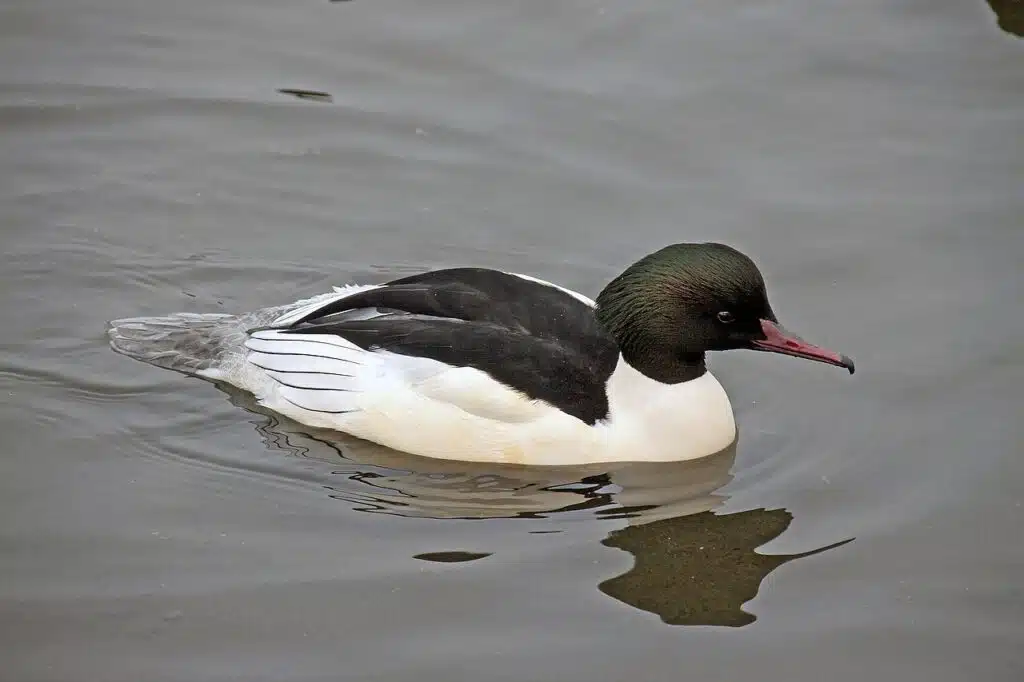
A black head, neck, and upper back are specific to this species. Males show a contrasting white belly and white wings.
Seaducks of the species are further known for moving in and out of lakes, with the seasons.
Some of its preferred breeding sights include the Northern territories of North America and Eurasia.
Females of the species are a bit more colorful than males. They exhibit additional gray and red-brown nuances.
The head of the female is more colorful going into the breeding season. For many other species, this isn’t the case as males are generally more colorful to attract more potential female breeding partners.
2. Ring-necked Duck

Freshwaters of North America are the home of The Ring-necked Duck (Aythya collaris). This is a white and black species that are spread out across North America.
Migrating with the seasons, it can make its way from the Northernmost parts of Canada to Central America.
Correctly identifying the species is typically based on the cinnamon-brown ringneck of the duck as its black and white colors don’t differentiate it from other species too much.
Males have a black head, neck, upper back, and chests. Their bellies and their wings are mostly white.
The ringneck of the species is narrow, often overlooked due to its dark nuances against black plumage.
Females lack the white plumage sections almost entirely. Dominated by gray and black nuances, females also lack maroon neckbands.
Seen all across North America, these ducks spend their days relaxing or looking for food.
Young ducks prefer insects while adults already master diving and go underwater or above water for plants to dabble.
3. Hooded Merganser
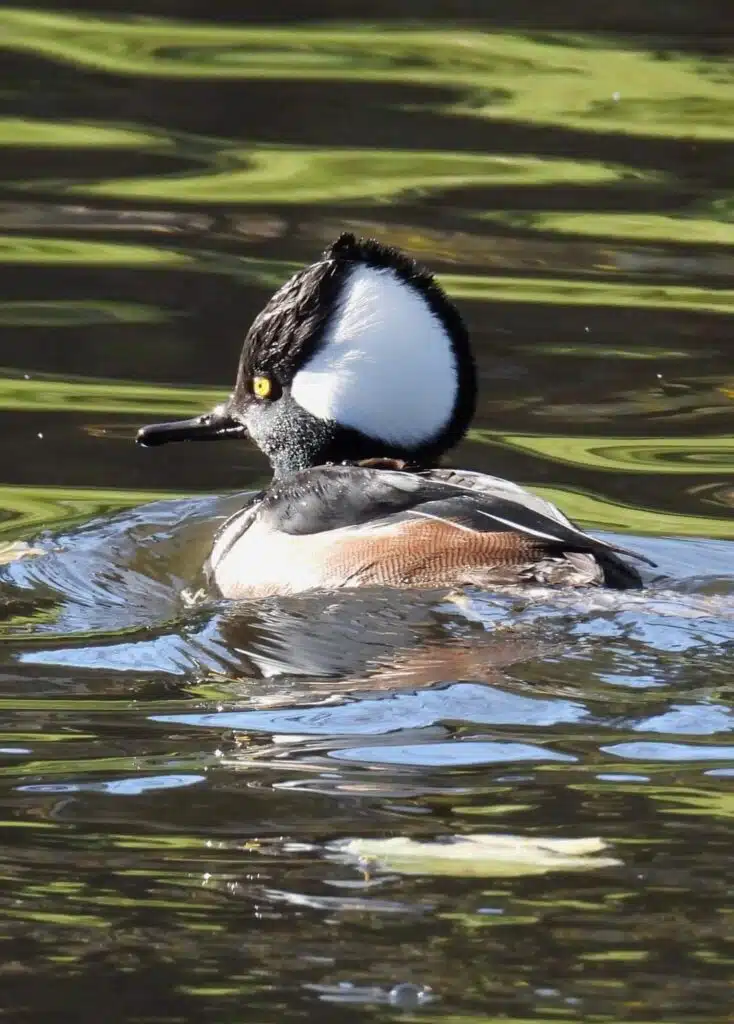
North America, especially the West and The East Coasts, are home to The Hooded Merganser (Lophodytes cucullatus).
Migration is specific to these ducks, but to a lesser extent compared to some of the most important North American migrating ducks.
This is a species featuring a tall crest, a distinct physical trait specific to females.
Males are dominated by black and white contrasting plumage plus additional brown sections on the belly.
Males have a black head and a black thin sharp beak. White sections are specific to the sides of its head.
Additional white stripes crest its black wings.
Ducks of this species are specialized underwater feeders. As a species of diving ducks, they can eat different types of aquatic wildlife.
Some of their typical foods include underwater plants. Small fish are also a high favorite of adult Hooded Mergansers.
4. Tufted Duck

3 main color patterns are specific to Tufted Ducks (Aythya fuligula). These patterns are specific to males, females, and ducklings.
The male of the species is mostly black and white.
Its black head shows a distinct crest that can sit up or down. Its black head and overall appearance are contrasted by its vivid yellow eyes and by its white underbelly.
Females have the second color pattern of the species. A chestnut-brown color is specific to females which only share the color of the eyes and beak with males.
Dominated by nuances of gray-brown, juveniles look similar to the females of the species.
Spotting these ducks may not be easy, despite a contrasting look. A nighttime feeder, the ducks rest during the day.
Some of the spots where they like to rest include calmer areas of the coast plus ponds.
5. Red-breasted Merganser

A crested head is among the first physical traits that stand out for The Red-breasted Merganser (Mergus serrator).
However, this is a species that shows different other stand-out traits, such as having different color plumage for males and females.
The male duck has a black head and a black crest with red eyes in the breeding season. Gray, white, and black nuances are further characteristic of the rest of its body.
Females are dominated by brown nuances and gray-brown heads. They also have a crest but show brown irises instead of red irises into the breeding season.
Other features of the species that impress include the high flying speed.
This is a species that may fly with a speed of up to 100 miles per hour, making it a species that easily covers large territories during the migration process.
High numbers of Red-breasted Mergansers migrate each winter. The UK alone numbers more than 10.000 ducks during the winter.
6. Lesser Scaup
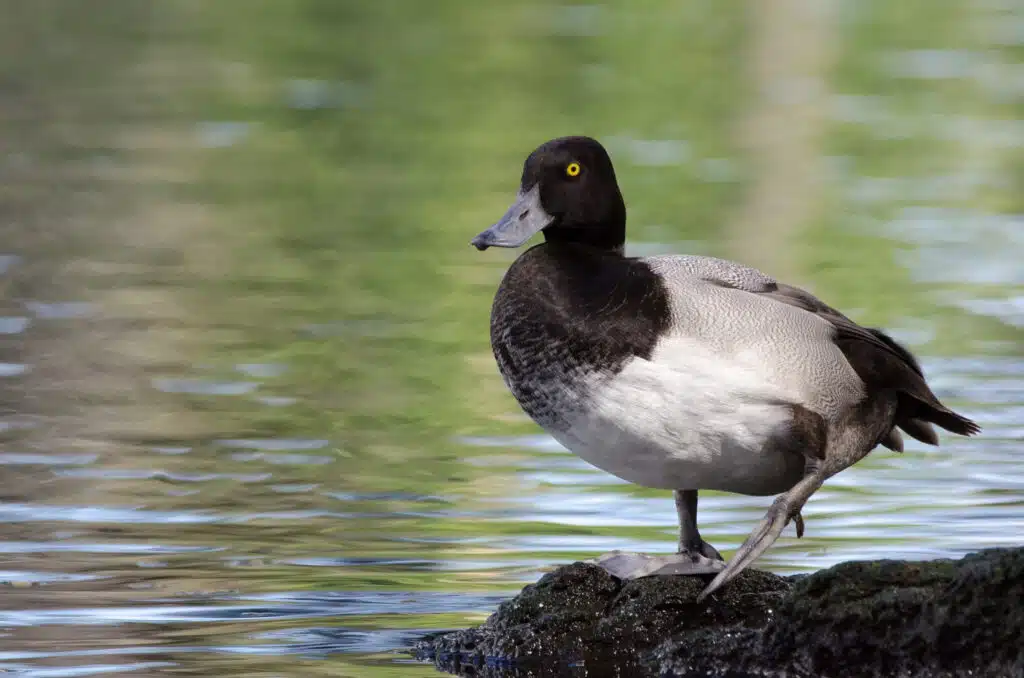
Also mostly black and white, The Lesser Scaup (Aythya affinis) is a species that still stands out with a few colorful traits.
Often referred to as The Little Bluebill, this is a duck that has a blue beak, both in the case of males and females.
In turn, it’s only the male that shows black and white plumage. There are further nuance differences in its black sections.
The black section on the back of the male’s head is marked by green iridescence.
This is a species that shows green plumage at the back of the head, going into the breeding season.
Bright underbellies are specific to its plumage.
Females are dominated by dark and bright brown nuances. They show a similar blue beak, with additional black patterns in the front.
Females aren’t known for having bright yellow eyes as the eyes of males either. They have brown irises throughout the season.
7. Common Eider
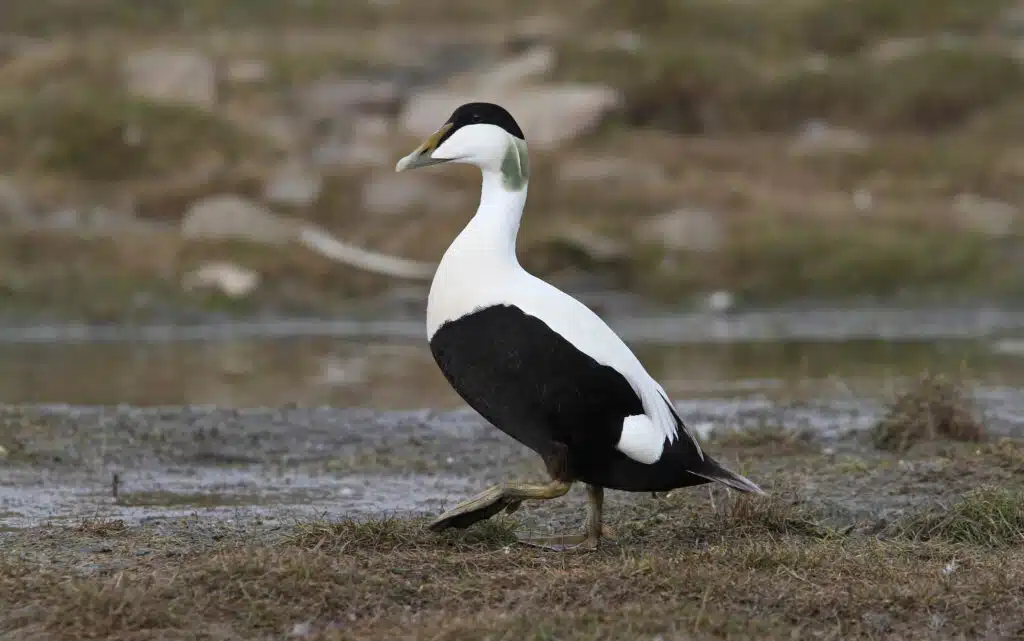
As the largest type of eider, The Common Eider (Somateria mollissima) is a duck species dominated by black-and-white nuances.
Eclipse plumage is mostly black with white patterns and a bright blue beak.
Non-eclipse plumage is dominated by white plumage with black patterns in males. A typical drake also has the same gray-blue beak and back of the head with a black crown in non-eclipse plumage.
Unlike different other types of wild or domesticated ducks, The Common Eider has a black underbelly with white top sections and not the other way around.
Females are dominated by gray and black nuances and almost appear completely black. They show a gray-brown beak, a black tail, and dark brown legs.
The female duck is also known for lining the nest with its own down for extra thermal protection for its laid eggs.
8. Long-tailed Duck

A species dominated by a black pointy tail, The Long-tailed Duck (Clangula hyemalis) is among the typical species with male and female discrepancies.
Males are black and white and females are mostly brown.
The male of the species has a white crown, a gray face, and a black back of the head. Its neck and underbelly are mostly white while its wings show a combination of white and black patterns.
Black and orange beaks are further specific to this species which shows red-brown eyes going into the breeding season.
Females, on the other hand, aren’t as colorful but still show a brighter and mostly white head with brown sections at the back of the head.
The female has a black beak but its plumage is mostly brown. A dark brown nuance is specific to the female.
Ducklings look similar to females but show a bright neckband as a differentiating pattern.
Some of the best times to spot these ducks is during the breeding season. Females are now seen nesting as they lay a small cluster of white-cream eggs.
9. Barrow’s Goldeneye
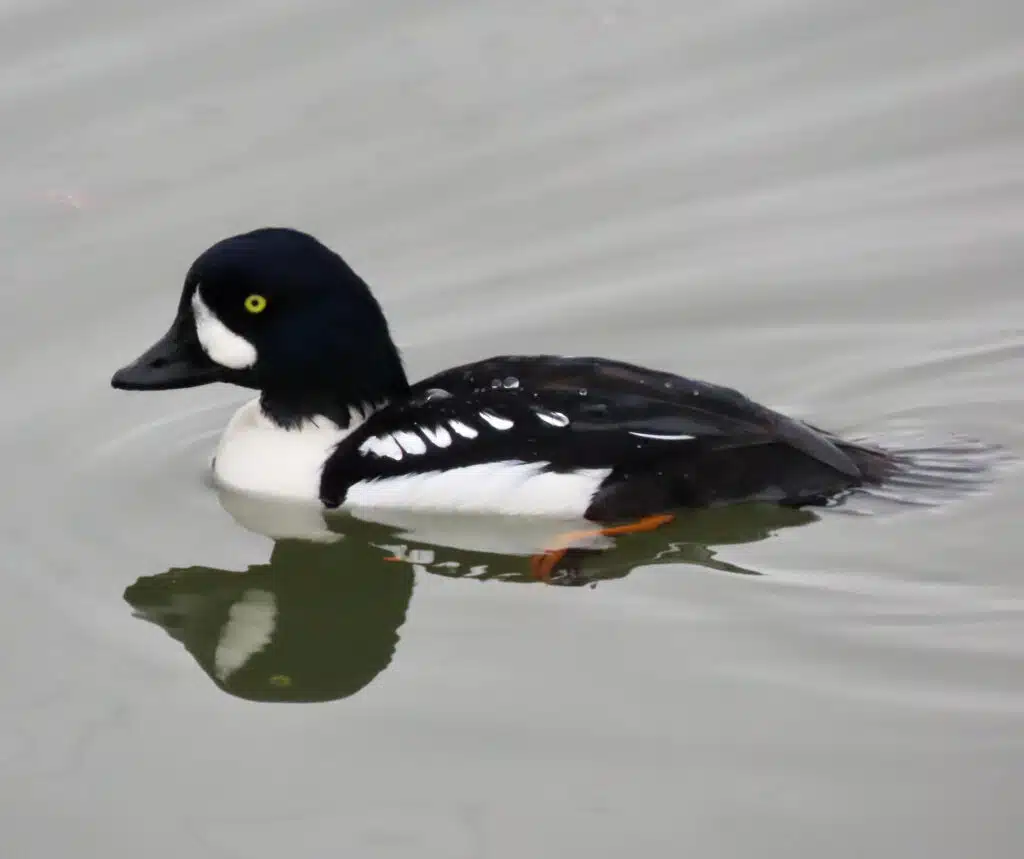
A species of black and white seaducks, Barrow’s Goldeneyes (Bucephala islandica) are named after the golden-yellow irises of males.
These types of ducks are only found in Northwestern parts of North America. They live here all the time or they migrate short distances, mainly along the West Coast, between Alaska and The United States.
Males of the species are the ones with black-and-white coloring.
They have an almost completely black head with white cheeks and a black beak. The neck and underbelly are mostly white with additional white sections on its black wings.
Further black sections are specific to its back and short tail.
Females are dominated by brown and off-white nuances.
As they approach the breeding period, males take on a green sheen head nuance that’s iridescent and stands out in the sun.
Ducks of the species can be seen looking for food such as mussels.
10. Smew

Male smews (Mergellus albellus) are almost completely white but still contrasted by black patterns.
Black patterns circle their eyes while the upper back is also black. Thin black stripes are seen at the base of its white wings as well.
Males also show distinct black beaks, the only similarity with the females.
Red-brown nuances are specific to the head of females. Gray and white plumage dominates their underside and their wings.
Females also show black cheeks in the breeding period while males can show gray wings going into the breeding period.
This species travels between Europe and parts of Northern Asia where they breed in a vast territory up to Japan.
Some research even shows Smews are some of the oldest ducks in the world.
11. King Eider

Atypical coloring and an atypical head shape are specific to male King Eiders (Somateria spectabilis).
The elongated head of males is white, gray, black, and yellow while their beaks are bright red.
Black and white Kong Eiders are more colorful than females, mostly when it comes to the plumage on the wings and body.
Females of the species are mostly brown, with a gray beak. Like most other types of seaducks, female King Eiders lay white or cream eggs in the summer.
These types of ducks breed in the Arctic Tundra and live along the Northern European, Asian, and Canadian coastlines.
Male King Eiders also stand out with the sounds they make as these may resemble the sounds of doves.
Both male and female King Eiders have diverse calls but, interestingly, females make low-pitched noises compared to males.
Both males and females can live long lives of almost 2 decades.
12. Radjah Shelduck

A species found around Australia, Radjah Shelduck (Radjah radjah) is a black and white species of ducks with a sporadic presence up to Indonesia.
Black and white nuances are mostly specific to these types of ducks, almost in equal parts.
The head, neck, and underbelly are all-white while the back and wings are mostly black, as is the tail.
Its beak is also almost white, having a bright cream color.
The eyes of the species are also almost white, with very bright irises.
Females have a similar appearance with a white and pink beak.
Ducks of this species have a varied diet starting with weeds and aquatic plants. They also eat aquatic insects, bugs, and different types of worms.
These types of wild ducks can be spotted as they mostly live along coastlines.
13. Greater Scaup
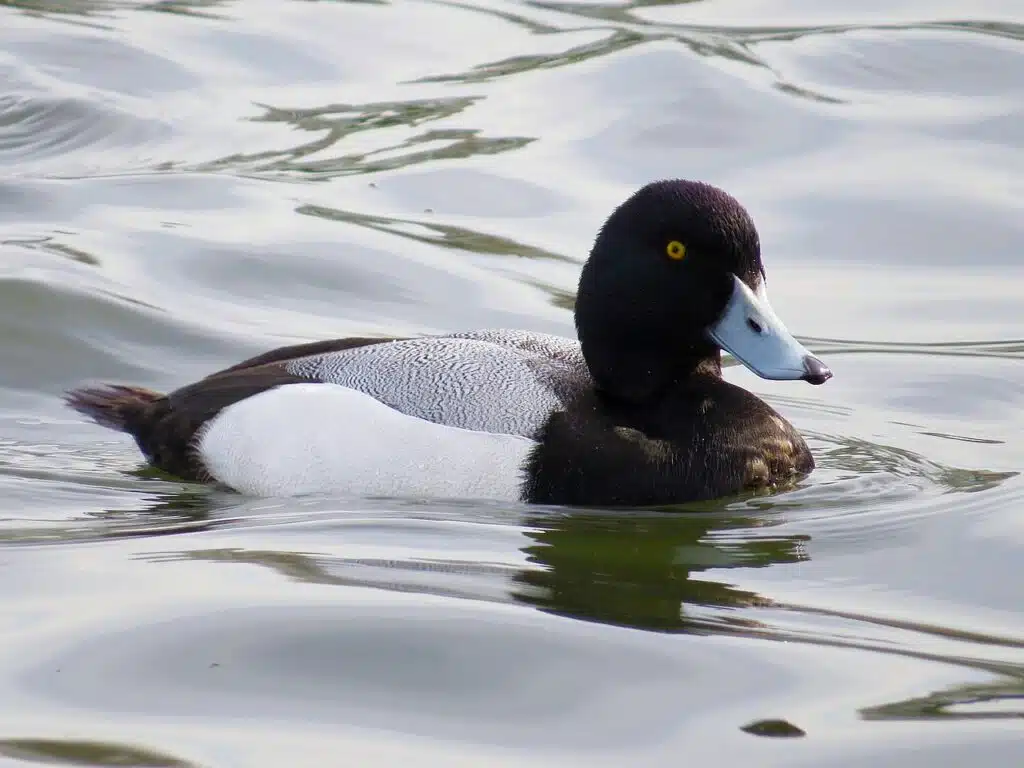
A species of diving ducks, Greater Scaups (Aythya marila) are known for their black and white colors and the ability to dive deep for food.
Some of their typical foods include mollusks. These ducks also eat seeds and other types of food in the winter, when other foods may be scarce.
A large type of diving duck, Greater Scaups reaches a size of up to 22 inches.
Black and white nuances are highly specific to the species, together with silver-gray nuances.
Its head is mostly black, turning black with green iridescence in the breeding season.
The neck is also black while its wings are white or black.
A bright blue beak and a gray-black tail complete the appearance of this large diving duck.
This species is adapted to the coolest climates of the world, even around the Arctic Circle and laying eggs in deep vegetation.
14. Surf Scoter

Almost completely black, Surf Scoters (Melanitta perspicillata) also show white sections on the base of the orange beak, on the face, and on the back of the head.
Males of the species are mostly black on the neck, wings, and underside.
Females are brown and black and lack the colorful beak of males as they have a black beak.
Surf Scoters are mostly found in the Northern regions of Canada.
These types of ducks are further seen along the East and West Coast of North America as they begin to migrate.
On their route back from their overwintering sites, Surf Scoters form pairs. These pairs are responsible for breeding, laying eggs, and initially taking care of the eggs and newly-emerged ducklings.
Ducks of this species are known to prefer the same breeding sites. They return to the same area and plan their departure dates according to the distance to their migration area.
15. Spectacled Eider
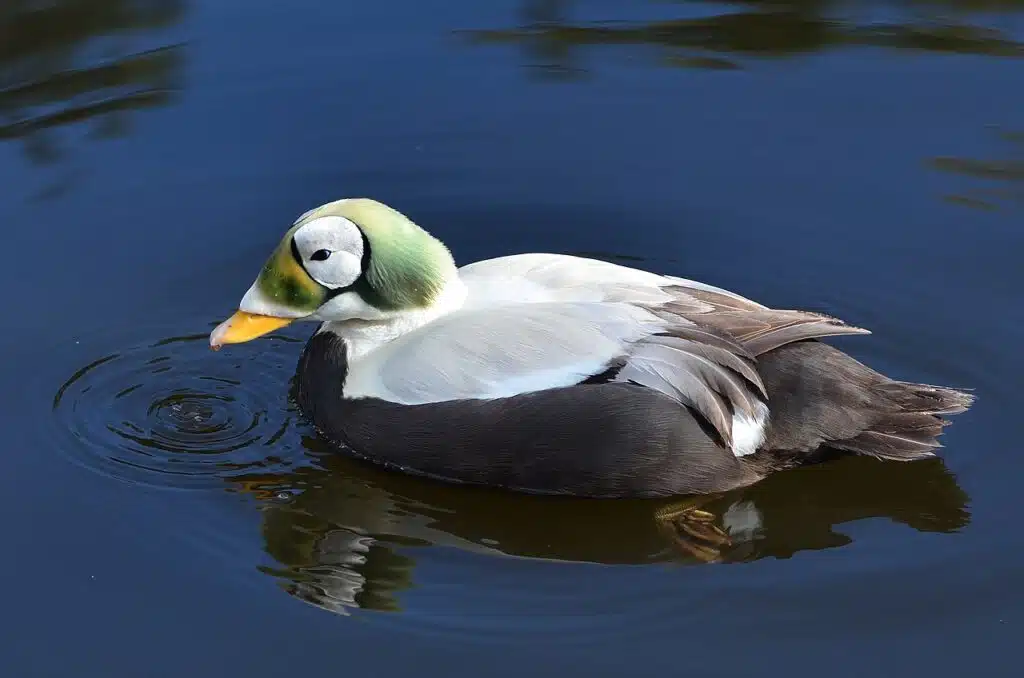
Named after the appearance of their heads and faces, these types of eiders (Somateria fischeri) show white round sections around the eyes, which are mostly gray-green.
Black margins separate the white sections and the gray-green sections of the head. Bright orange beaks are also specific to male Spectacled Eiders.
Most black and white sections are seen on the rest of its body, on the other hand. These are represented by black wings and underbellies and white base sections of the wings and upper backs.
Females are also spectacled. They feature a dark brown head and bright brown spectacles.
Dark brown coloring is further seen across the body which shows thin black lines as well.
A species of The Bering Sea, Spectacled Eiders are mostly seen in East Russia.
This is a species that builds nests on the grown and a type of duck that lays green eggs.
16. White-headed Duck

Much of the appearance of the White-headed Duck (Oxyura leucocephala) separates this species from other black and white head ducks due to the coloring of their heads.
This is a species with a mostly white head that features black stripes. A white head is specific to male ducks which have a black crest-like band and a blue bill.
Females have smaller white sections on their heads with gray-black bands and stripes.
Both males and females are dominated by brown plumage, on the other hand.
A partially migrating bird, this is a duck of the seas and of freshwater as it moves from Southeastern Europe to Central Asia and down to India.
Strays of the species have also been spotted in Alaska.
A very good type of swimming duck, The White-headed Duck is a species that feeds on different types of submerged plants.
17. Velvet Scoter
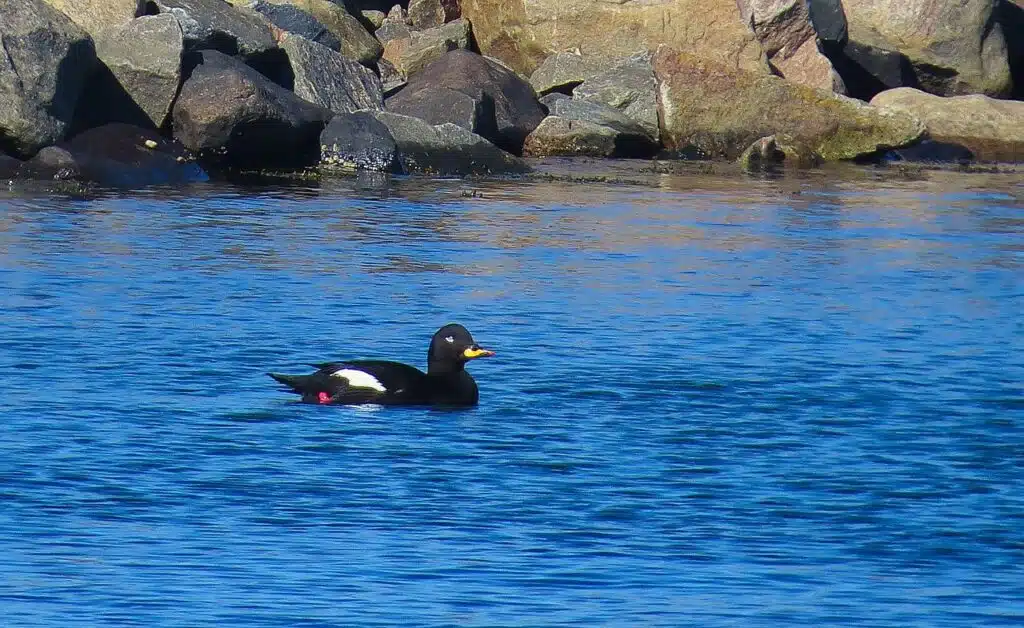
Mostly black and only partly white, Velvet Scoters (Melanitta fusca) are some of the darkest types of ducks in the world.
Males show a black head with thin white circles around the eyes and a bright yellow-orange beak.
While the rest of the body is also black, males have white stripes across their black wings as well.
The females of the species are also highly similar, but still clearly different.
Their black head doesn’t show white circles around the eyes and their beaks are black as well.
Bright brown sections are present around the beak of the female.
Female Velvet Scoters additionally show white stripes on the wings.
Partly migratory, Velvet Scoters are present in regions of Europe and Asia. Western Europe marks the Western limit of its habitat while East Asia marks its Eastern limit.
Regions of The Black Sea and The Caspian Sea mark the non-breeding habitats of Velvet Scoters.
18. Stejneger’s Scoter

Also known as The Siberian Duck due to its prevalence in Siberia, this (Melanitta stejnegeri) is a mostly black type of seaduck.
Its coloring is dominated by a black head, neck, wings, and underbelly.
White sections are small, and typically tied to the area around the eyes and the wings.
While black, this type of duck also has an orange beak.
Much of its presence is tied to Northern regions of Asia but occasional sightings are also noted in Northern parts of North America. The duck can be seen around Alaska on some years.
The same occasional sightings are also noted in Central regions of Asia up to Central China.
Seaducks of this family are known to live in freshwater and saltwater, showing adaptability to their diets.
Much of its life remains undiscovered as Stejneger’s Scoters have just been named as an individual species and not a subspecies.
19. Scaly-sided Merganser

Scaly-sided Mergansers (Mergus squamatus) sometimes overlap the region of another black and white species, Stejneger’s Scoter.
However, Scaly-sided Mergansers are found further East, up to Japan.
Even more, Scaly-sided Mergansers have a more contrasting appearance based on their similar black and white sections.
The upper side of the duck is mostly black. This includes the head and the back of the neck.
Its underside is white but there’s an additional yellow transition area on the sides between these colors.
A long thin brown beak is specific to the male. A black crest at the back of the head completes the appearance of the male.
Females are also crested but show a brown head with black sections around the eyes.
A long red-brown beak is further specific to the female which is dominated by gray and white plumage.
A species mostly found in rivers, this is a type of duck where the female lacks the black color on the wings and back, making it appear as a gray duck when swimming rather than a black and white duck as a male.
20. White-winged Duck
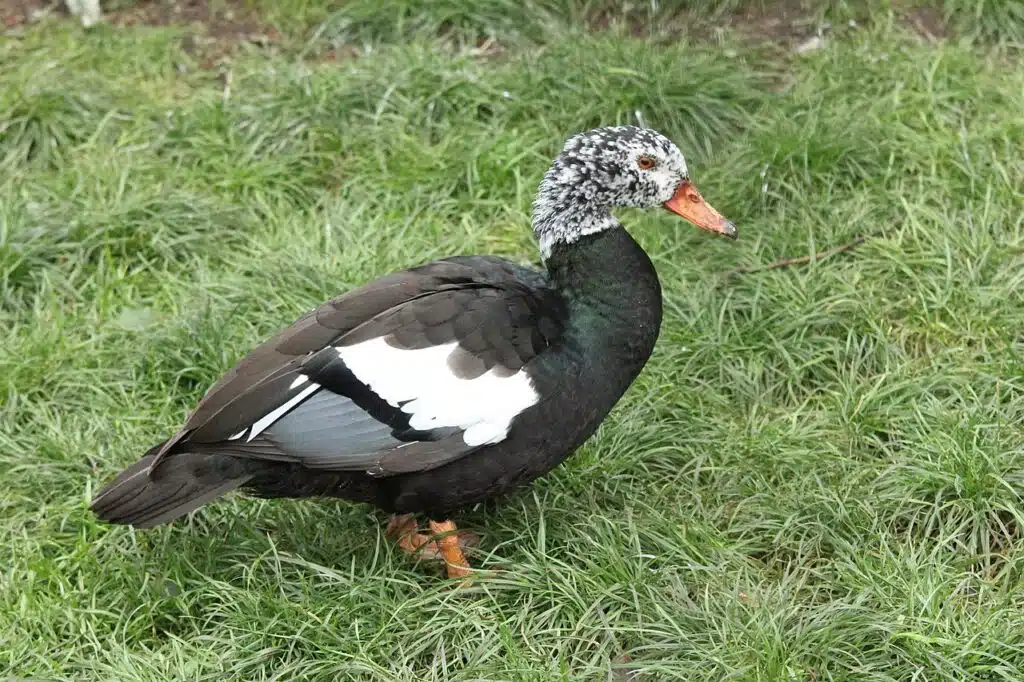
Both the region and the appearance of White-winged Ducks (Asarcornis scutulata) separates them from most other black and white ducks of the world.
This is a species found in Southeast Asia, as far South as Indonesia.
Male and female White-winged Ducks have mostly white heads.
Pale gray spots are seen across the head of the male which also has a dark brown beak.
Red irises complete the head of the multicolored head males of the species are known for.
Dark brown and black nuances are further characteristic of the males of this species.
Females are highly similar. However, they have larger gray spots on their white heads and orange-brown eyes with matching beaks.
Females additionally have brown bodies and wings with extra black and white sections across the outer wings.
Apart from these small coloring differences, female White-winged Ducks are also smaller than males.
21. Canvasback
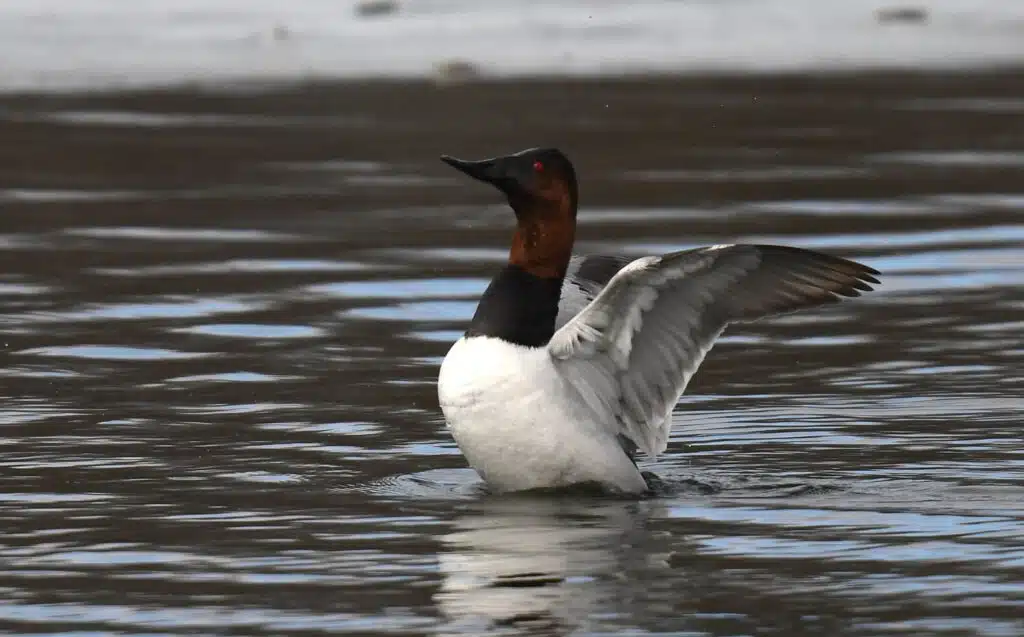
With a size of up to 22 inches, Canvasbacks (Aythya valisineria) are some of the largest types of ducks in North America.
Brown, black, and white nuances are specific to the drakes of the species.
A brown and black head is seen on males which shows a black upper back.
Their wings are mostly gray but they have white sections towards the base and additional black sections towards the tips.
Bright brown nuances and dark brown nuances are specific to females. The lower neck is the only brown-black section of females.
These ducks were once a popular species on the menus of various local North American restaurants.
While not fully protected today, many Canvasback populations breed in protected areas which protects them as well.
22. Harlequin Duck
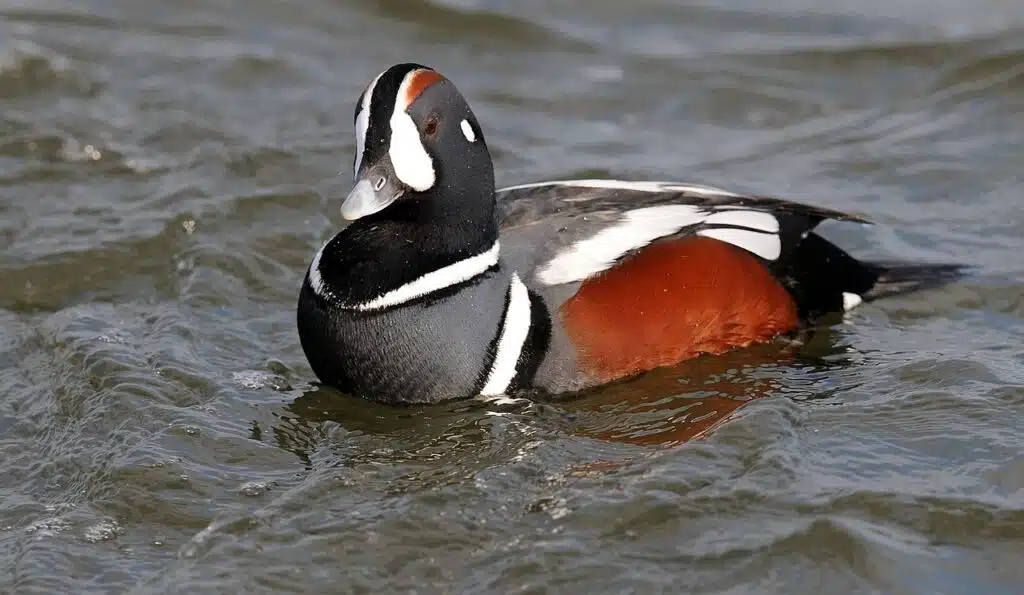
A multicolored appearance is characteristic of The Harlequin Duck (Histrionicus histrionicus).
This is a duck species with gray, black, white, and red nuances.
Its head is dominated by all of these color combinations. There’s a black crest with white and gray margins.
The black base color of the head is contrasted by white sections around the eyes while the beak is white or gray.
Gray chests with black and white stripes are further specific to males. Red and red-brown sections are specific to the wings of the species.
Females are only partly black and white and mostly brown. Small black and white sections are specific to the head of the female.
Males and females are seen together more commonly than other species. Harlequin Ducks form breeding pairs that last 2 or more years, unlike many other species of ducks.
23. Knob-billed Duck

Both male and female Knob-billed Ducks (Sarkidiornis melanotos) are dominated by black-and-white nuances.
It’s only the males that have a black knob-like formation on the top of the beak, on the other hand.
A black head and neck with black spots are specific to the male, together with a black beak.
Black wings and a gray underside complete the looks of Knob-billed Duck drakes.
Females are largely similar, with a white head and black wings. On the other hand, females don’t have the beak knob-like formation.
Some rare patterns are also known for the species. A white and brown Knob-billed Duck exists in parts of Africa.
Even more, the black sections on the male Knobb-billed Duck may show green iridescence going into the breeding season.
Knob-billed Ducks also show blue or violet iridescence on the wings and tails in regions of South Africa.
24. Bufflehead

Some of the largest black and white ducks are found across North America. This (Bucephala albeola) is also the case with some of the smaller ducks of the world.
Buffleheads reach a size of just up to 14 inches, being among the smaller species of the continent.
They show black and white patterns with iridescence in the case of males and black and gray colors in the case of females.
Much of their ventral side is white while the head is black and white, in the case of drakes. Green and even purple iridescence is still seen on the black and white head of the male.
Short gray beaks complete its colorful head appearance.
Females have darker beaks and a mostly black head that features white side stripes. Gray and black colors dominate the underside and the wing coloring of the female.
While small, this duck moves all across the continent when it migrates.
The habitat of the species expands from Alaska to California and Eastwards to the East Coast.
25. Common Goldeneye

Slightly larger than Buffleheads, Common Goldeneye ducks (Bucephala clangula) also show green iridescence on the head.
This is a type of North American duck with mostly black and white males.
The dark head of the species turns iridescent green going into the breeding season. White cheeks are specific to this species in this period.
Males show vivid yellow eyes and a short black beak as well.
Females also have a differently-colored head. They have a brown head with yellow eyes and mostly gray underside plumage.
There are also white patches across the wings of the females with additional dark brown sections on the inner wings and upper body.
These nuances can show some degree of variation as there are 2 Common Goldeneye subspecies in the world.
One dominates the North American space while the other dominates Eurasia.
26. Common Shelduck
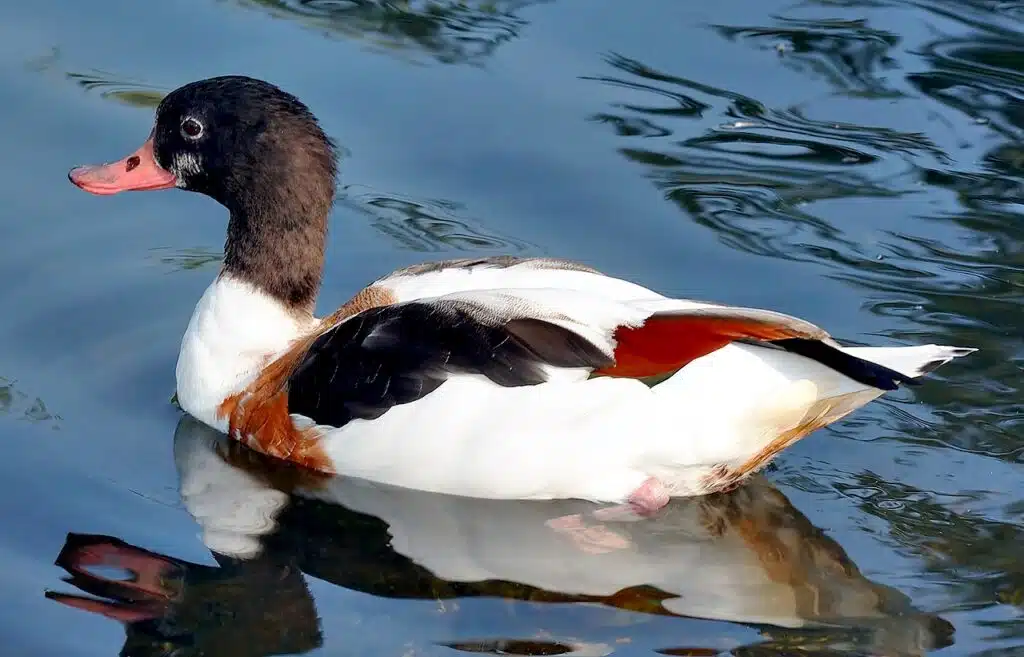
Black and white are common colors Common Shelducks (Tadorna tadorna), along with red and brown.
Males of the species also show green iridescence on the wings. As with other species, this is only a color specific to breeding males.
Male Common Shelducks only show green iridescence on the inner lower part of the wings, rather than on the head with most other species of ducks.
The head is mostly black. Black and white sections dominate the wings while the underside is also white.
Unlike females, males also show a vivid red beak while females have a pale pink-red beak.
Females also have a brown head rather than a black head but still have large white sections along the chest, underbelly, and wings.
This European species of ducks has exclusively black and white ducklings.
27. Comb Duck
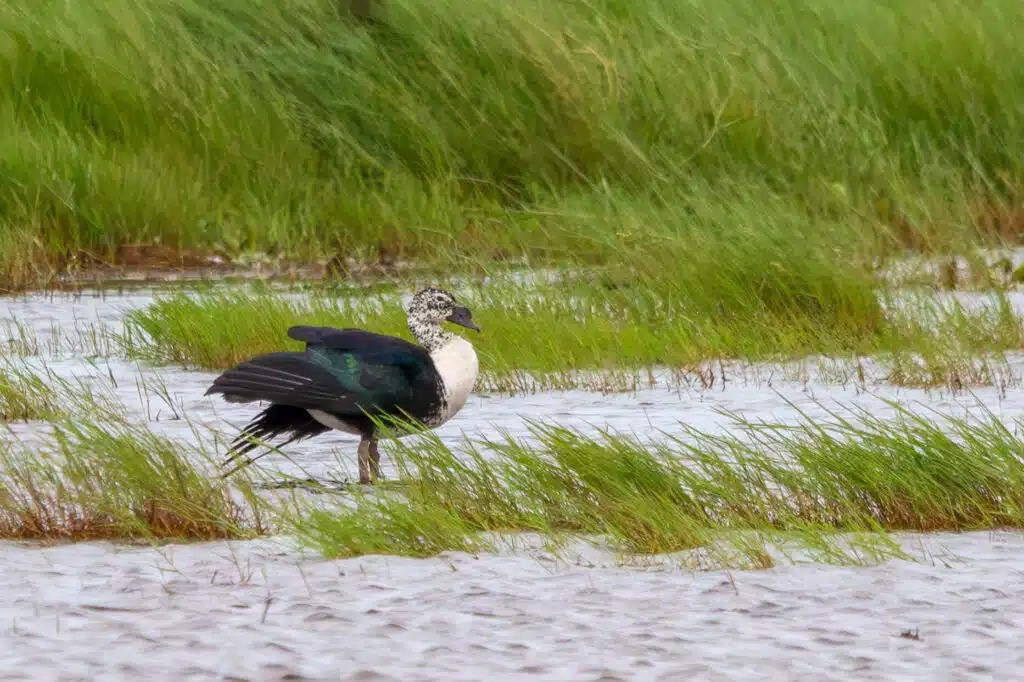
Comb Ducks (Sarkidiornis sylvicola) impress with their black and white color combinations and their size.
As one of the larger ducks in the world, Comb Ducks grow to a size of up to 30 inches.
Similar in size and color, males and females still show a few differentiating physical traits.
Among them, the large black knob on the male’s beak is the most spectacular.
This is an attraction trait males rely on to lure in more prospective mates.
Males also show green iridescence on the wings to lure in females.
A mostly white head with black spots is further specific to males. A white chest and underbelly are also contrasted by black wings and a black back in male ducks.
Females are also similar, but most black sections across the wings are dark brown, as opposed to males.
The female has a white head with black spots, a gray-brown underbelly, and dark brown and gray wings.
28. Steller’s Eider
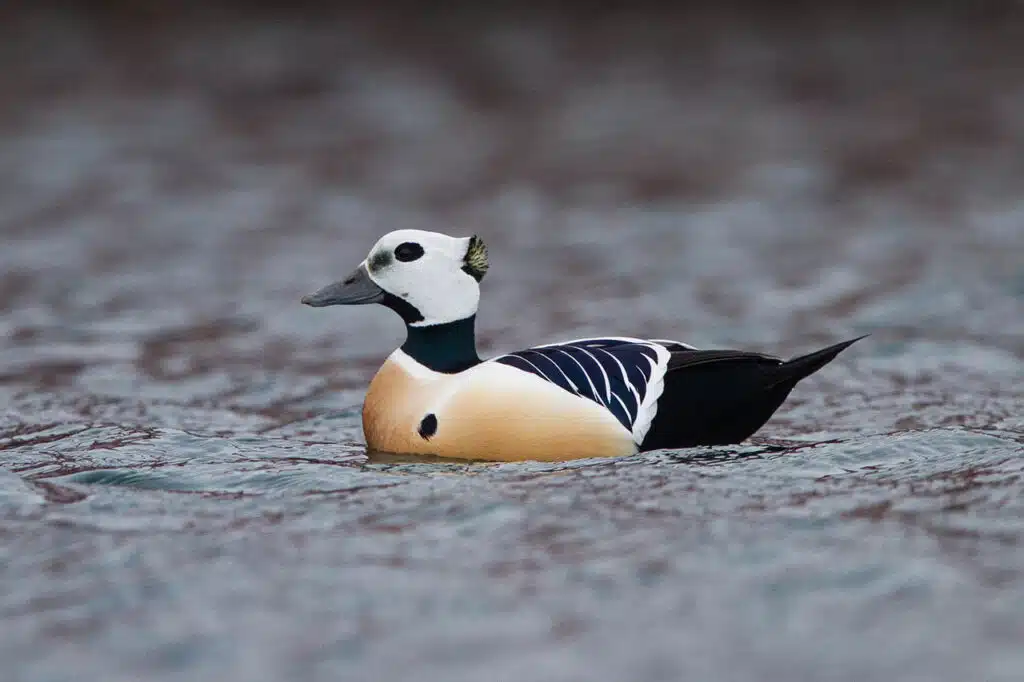
A species rarely seen due to its habitat in vast and uninhabited tundra, Steller’s Eider (Polysticta stelleri) is a marking duck with black and white nuances.
Males have a white head with different black patterns. These are patterns like black circles around the eyes or a black back-of-the-head crest.
Males also show a black beak, a black neck, black wings, and tails.
Red-brown nuances are specific to its underbelly.
Dark brown and black nuances cover the plumage of females, which aren’t as colorful as the male.s
Some color variation is specific to this species, mainly through seasonality or location.
East Russia, West Russia, and Alaskan Steller’s Eiders can come in their own nuances.
A known diver, the duck feeds next to the shore. It does this in large numbers as thousands of ducks can live in the same place.
Thousands of Steller’s Eiders also molt together, preferably in Arctic lagoons.
29. Magpie Duck

Magpie ducks are among the few black and white domestic ducks in the world.
This species is always black and white, as this was a characteristic the ducks were intentionally bred for, in Europe.
Magpie Ducks were intended to look like The Common Magpie, which is also black and white.
Mostly white, the duck shows a black crest, black wings, and a black tail. Their black and white look is only contrasted by an orange beak and orange legs.
Blue and black are also color combinations sometimes accepted for Magpie Ducks.
A species with diminishing numbers across The United Kingdom and Europe, Magpie Ducks are now bred for show.
Their intentional initial breeding was focused on meat and egg production.
30. Ancona Duck

Much of the history of Ancona Ducks is unknown. Some say it originated in North America while others say it originated in Europe, together with Magpie Ducks.
Ancona Ducks are also mostly black and white. This is a species with an almost fully white head.
The head and face of the species also show additional black dots or spots without a particular pattern.
Large and small black dots can be seen all around its head.
The neck of the duck is completely white, on the other hand. A full-white color is also specific to the underside of these ducks.
Its wings are mostly black, with white sections on the inner wings. Its short tail is also black.
Ancona Ducks may have an orange beak or a yellow beak, depending on their region.
Yellow-beak Ancona Ducks typically show additional black patterns on the beak and black patterns on the chest.
Ancona Ducks are excellent at egg production, laying 1 egg every day or every other day.
These eggs are cream-colored but they can also be blue or gray.
31. Swedish Blue
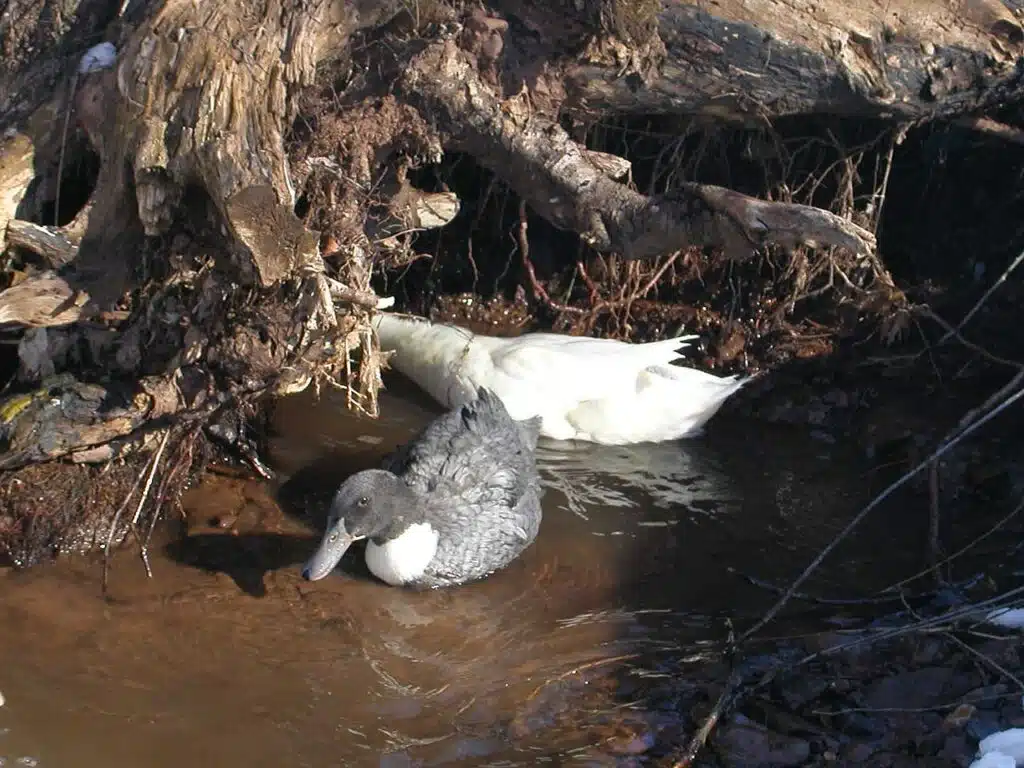
Swedish Blue ducks come in 3 color patterns, including a black and white pattern.
This is a mostly black duck with a white neck spot.
Gray ground colors are also specific to these ducks which have additional white sections on the neck. As the name implies, this gray duck can also have a blue nuance.
A mostly white Swedish Blue Duck is also a common sight.
Swedish Blues are recognized for their temperament, meat, and eggs. While not as productive as other domestic ducks, the breed is still recognized for its egg-laying rather than for its show traits.
One of the main challenges with the species is breeding true blue ducks.
Even when both male and female parents are blue, the result is mostly gray, black, and white duck with reduced blue tint sections.
These types of ducks are also ideal for families as they have a friendly nature, although they may prefer hiding as they can be shy at times.
32. Hook Bill

Male Hook Bill ducks are mostly black, gray, and white. This type of duck is becoming a rare sight.
Most of the European countries it used to be found in are already areas where the species has disappeared from.
Its long gray bill is what the species is known for, together with the green head and back of the neck for males.
This is also a species with black wings, a white chest and front neck, and gray underbellies.
Its long beak and colored appearance are noted and drawn in documents from hundreds of years ago.
Hook Bill still has an uncertain origin and the species isn’t as popular as other domestic ducks despite laying more than 100 eggs per year.
33. Muscovy Duck
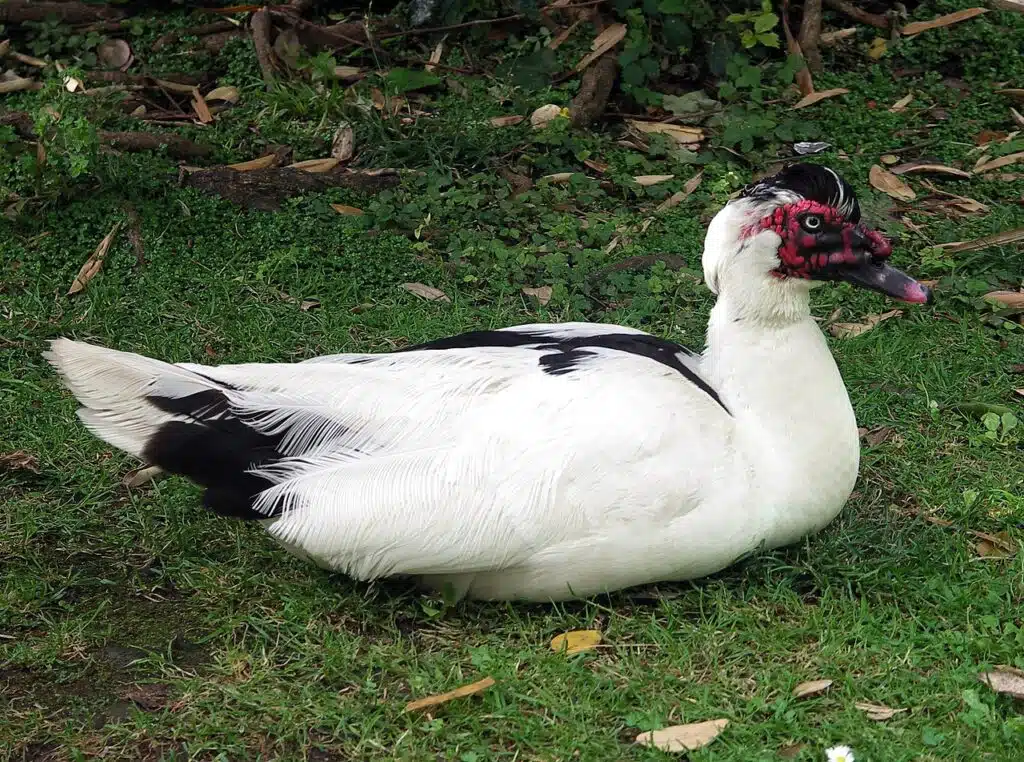
Muscovy Duck Drakes (Cairina moschata) are black and white. Some color variations are specific to these drakes since the species is present across The Americas.
Drakes can be all-black with just a few white sections on the wings or they can have a mostly white head with black spots.
Its wings and underside are mostly black. Male ducks also show a green sheen on their wings into the breeding season.
The exposed red skin on the face can also contrast the otherwise dark appearance of these ducks.
A small number of eggs are laid by females each year. Unlike the blue or green eggs of Hook Bill ducks, Muscovy Duck eggs are cream-colored.